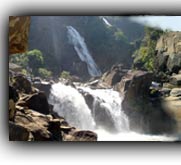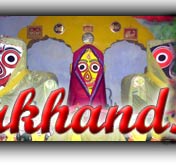 |
 |
 |
 |
 |
- Welcome
- Search TravelJharkhand.com
 Jharkhand culture is rich and diverse and as a result unique in its very own way. Jharkhand culture treats guests as God and serves them and takes care of them as if they are a part and parcel of the family itself. Archaeologists have unearthed pre-Harappa pottery, pre-historic cave paintings and rock-art from various parts of Jharkhand. That hint at ancient, cultured civilizations inhabiting these parts. The intricate woodwork, the pitkar paintings, tribal ornaments, stone carvings, dolls and figurines, masks and baskets, all are pointing towards the cultural wealth of Jharkhand existed even before the Harappa age.
Among the most delicate, fragile, beautiful and threatened indigenous tradition of India are for example, the Kohvar and Sohrai paintings, which are sacred, secular and relevant to a woman’s world. This is the part practiced exclusively by married women, during weddings and at harvest time, and the skill and the information is handed down to younger females of the clan.
Comb-cut of finger-painted Kohvar art celebrates marriage, and the wall-painted Sohrai, bumper crops. Elaborate design motifs, animal and plant forms, fertility motifs are abundant and often echo ancient cave art found in the surrounds. The colours used are all natural shades, red oxide from stone, red ochre, kaolin white, manganese black earth etc.
Jharkhand culture is rich and diverse and as a result unique in its very own way. Jharkhand culture treats guests as God and serves them and takes care of them as if they are a part and parcel of the family itself. Archaeologists have unearthed pre-Harappa pottery, pre-historic cave paintings and rock-art from various parts of Jharkhand. That hint at ancient, cultured civilizations inhabiting these parts. The intricate woodwork, the pitkar paintings, tribal ornaments, stone carvings, dolls and figurines, masks and baskets, all are pointing towards the cultural wealth of Jharkhand existed even before the Harappa age.
Among the most delicate, fragile, beautiful and threatened indigenous tradition of India are for example, the Kohvar and Sohrai paintings, which are sacred, secular and relevant to a woman’s world. This is the part practiced exclusively by married women, during weddings and at harvest time, and the skill and the information is handed down to younger females of the clan.
Comb-cut of finger-painted Kohvar art celebrates marriage, and the wall-painted Sohrai, bumper crops. Elaborate design motifs, animal and plant forms, fertility motifs are abundant and often echo ancient cave art found in the surrounds. The colours used are all natural shades, red oxide from stone, red ochre, kaolin white, manganese black earth etc.
Different Traditions in Jharkhand culture
Each sub-caste and tribal grouping of Jharkhand has a unique tradition to uphold.
Oraon: Oraon comb-cut paintings can be traced back to ancient times. Images of cattle, feeding troughs, papyrus, birds, fish plants, circled lotus, zigzag, square, opposing triangle geometric forms, arches in series-are common. Floral art forms are used during harvest time.
Ganju: Ganju art forms are characterized by images of animal, wild and domesticated, and plant forms. Large murals of animal, birds, and floral exotica, decorate homes. Endangered animals are often depicted in picture-story tradition.
Prajapati, Rana & Teli: Prajapati, Rana & Teli the three sub-castes decorate their homes with plant and animal fertility forms, using both finer painting and comb cutting techniques. The ‘prajapati’ styles uses filigree work, with emphasis on zoomorphic plants representations and Pashupati (Siva) the God of Animals, and floral motifs filled with colour.
Kurmi: Kurmi, a unique style of ‘sohrai’, where drawing outlines are scratched onto the surface of wall with nails and a wooden compass is used to etch the segmented lotus, Pashupati or Lord Shiva is depicted as a horned deity on the back of a bull, Red, black and white lines are drawn in pairs on either side to represent the ashes of ancestors. The Kurmis of Bhehwara use glyptic art to represent plants on the walls and floors of their homes.
Mundas: Mundas use their fingers to paint in the soft, wet earth of their homes and use unique motifs like the rainbow snake and plant forms of deities. Lavender-gray coloured mud from rock-art sites next ot Munda villages, are used with ochre mud as contrast colour.
Ghatwals: Ghatwals use glyptic paintings of animals on their forest dwellings.
Turi: Turi who are a small community of basket-makers use predominantly floral and jungle-based motifs in natural earthy tones on the walls of their homes.
Birhor & Bhuiya: Birhor & Bhuiya use simple, strong, and authentic graphic forms like ‘mandalas’, painting with their fingers, Crescents, stars, yoni, rectangles with corner petals, ovals with flared lines and concentric circles, are common.
Manjhi Santhal: The striking warring figures painted in black o simple clay plaster walls are startling reminders that their origins probably had links with the Indus Valley civilization.
Different Crafts in Jharkhand culture
Superb craftsmen for generations, the tribal communities of Jharkhand have created and perfected exquisite works of art based in the rich and unique natural resources of the land this have to be seriously mentioned when talking about Jharkhand culture.
Jharkhand abounds in forests that have a variety of wood for producing several articles of household use. The wood craftsperson of this region carve various attractive articles like door panels, boxes and windows, wooden spoons etc. for household use. The Slender strong and supple bamboo is sculpted into beautiful and practical articles such as door panels, boxes, spoons, hunting and fishing equipment, boat-shaped baskets, rice huskers and bowls that are smeared with pink and leaf-green powder on ritual occasions.
‘Pattal plated and bowls made from ‘sal’ leaves and ‘Sabai ghaas’ are used widely during wedding and other festivities. ‘Sabal ghaas’ or wild grass is woven into bowls, pens-stands, coaster and mats, or dyed and woven into intricate and colourful boxes, dolls, table mats and Christmas tree decoration, Chailbasa region famous for these.
Toupadana near the capital city of Ranchi makes very unusual wooden toys that are completely abstract. They are just pieces of wood painted to look like human figures with angular lines but no separate limbs. Hands are indicated only by painting lines on the body. The toys are always in pairs -- man and woman wearing different crowns, costumes and ornaments. They are breathlessly stunning and very original as they are different from any other doll. There are many other small villages around Ranchi have for generations created finger painted toys from palm leaves, some with detachable limbs and wheels for mobility. These toy-makers create elaborate toys based on the wedding of Lord Rama, and brilliant parakeets with red beaks and paddy green feathers.
Metal Masterpieces
Dokra, the ancient metal crafts which has caught the interest and attention of the worldwide artistic community, is practiced by the Malhar and Tentri tribes of Jharkhand.
Primarily created from brass scrap, the objects have a core of clay concealed within the metal casting. Hand-crafted, intricately worked figurines, village tableaux, drummers, elephants with howdahs, oil lamps, peacocks – the range is as creative and varied as the imagination and skill of the crafts person. No Dokra sculpture is an exact duplicate of another- each one is authentic and original.
Other than art objects, tribal metal craftsmen make a range of interesting, innovative and classically beautiful products in black metal, and traditional ‘kansa’ or bell metal, with a matt black finish on the outside, and shiny golden finish on the inside. Tribal Jewellery here needs special mention here-crafted in gold, silver or white metal.
Wide bracelets called choor in a spectacular design range; large conical tops bala and tarpat earring with flat worked chains that go over the ears are some traditional items. Immensely popular is a string of three chains with a flower-shaped clasp or heart-shaped filigree clasp at both ends. Large heart-shaped hair-clips called tara kata and paan kata are worn in a pairs. Mandli chokers with simple half-moons strung on black thread and designed to fit snugly on the throat, come with matching earrings. Hasli, the thick, plain choker dipped in gold features tribal graphic etched into it surface. Bead necklaces are ever popular.
‘Kanghee’ combs are wonderful items for use and décor. Wood axes with tribal motifs burnt into their handles, are collector’s items, but found in almost any weekly ‘haat’ or village bazaar.
Upturned, bowl shaped umbrellas of cane are used in fields, but can be used in any corporate garden. Finely carved door panels, wood inlay boxes, wooden Crosses and Virgin Mary figurines and the crown of thorns rendered in wood –are crafted in villages like Khunti.
Tribal theme toys and carvings, like a band of drummers, ancient ‘bird-woman’ figurines, statuettes of tribal leaders like Birsa Munda and those of mighty and mythological animals such as the Rhino, all created in wood, will delight connoisseurs and art-collectors and scholars alike.
Clay Works
The soil of Jharkhand is particularly suited to the needs of the artist and the craftsman. So the profusion of clay elephants, pots painted in brilliant hues and embellished with rural motifs, foot-scrubbers, clay figurines, jugs and masks of variety, are plentiful.
During festival season, idol-craftsmen from Bengal flock to Jharkhand to make their brand of artistry in the form of resplendent idols of Durga, Kali, Saraswati and other deities, from bamboo, straw, clay colours, tinsel, pith and other decorations.
The masks made in this state are very different from those made in the neighbouring state of Bihar. The masks are rather primitive and fierce and represent what in India is known as tamasik, a manifestation of the moral elemental passions in which every bodily form as well as facial expression is highly exaggerated. The ‘painted mask’ tradition of Jharkhand is truly legendary. In the early days, masks were made of leaves, but today’s highly stylized masks use a variety of materials like wood, pumpkin, gourd, cloth , even paper masks. Masks are intrinsic to the outstanding folk-dance form known as Chhau. Mythological masks for dancers, animal masks, with separate colour combinations and facial expressions are dream collector’s items from the Jharkhand region.
Languages
Jharkhand is home to a number of languages belonging to three major language families. Indo-Aryan languages include Angika, Bhojpuri, Khortha, Nagpuri, Sadri, Hindi, Urdu, Oriya and Bengali. Jharkhand is also home to the Munda languages, Kurmali, Korku, Santhali, Mundari, Bhumij, Kharia and Ho, and the Dravidian languages Korwa, Oraon(Kurukh) and Paharia (Malto). Santhali , Mundari , Kurukh, Khortha, Nagpuria, Sadri, Khariya, Panchparagnia, Ho, Malto, Karmali, Hindi, Urdu, Bangla etc are the most common languages. In whole of Santhal Parganas area Angika is the primary language for communication.
Folk Painting
The Jharkhand area is famous for a special type of folk painting called the paitkar paintings. This form of painting is one of the earliest forms of tribal paintings in India and thus enhances the culture of Jharkhand. These paintings have a scrolling look and depict life after death. However, due to lack of recognition and promotion, this type of painting is slowly facing extinction.
Folk Music includes Akhariya Domkach, Dohari Domkach, Janani Jhumar, Mardana Jhumar, Faguwa, Udasi, Pawas, Daidhara, Pahilsanjha, Adhratiya, Vinsariya, Pratkali, Jhumta etc.
Folk dances include Paika, Chaw, Jadur, Karma, Nachni, Natua, Agni, Choukara, Santhal, Jamda, Ghatwari, Matha, Sohrai, Lurisayro etc.
Instruments commonly used in Jharkhand area are Bansuri, Arbansi, Sahnai, Madanvari, Singa, Sankh Mandar, Dhol, Dhak, Dhamsa, Nagara, Damama, Karha, Tasa, Jurinagra, Visamdhanki, Thapchanchu, Kartal, Jhanjh, Thala, Manjhira, Ghanta
|
Home COPYRIGHT © 2008 TravelJharkhand.com | | Designed and Developed by GIGISOFT Solutions |